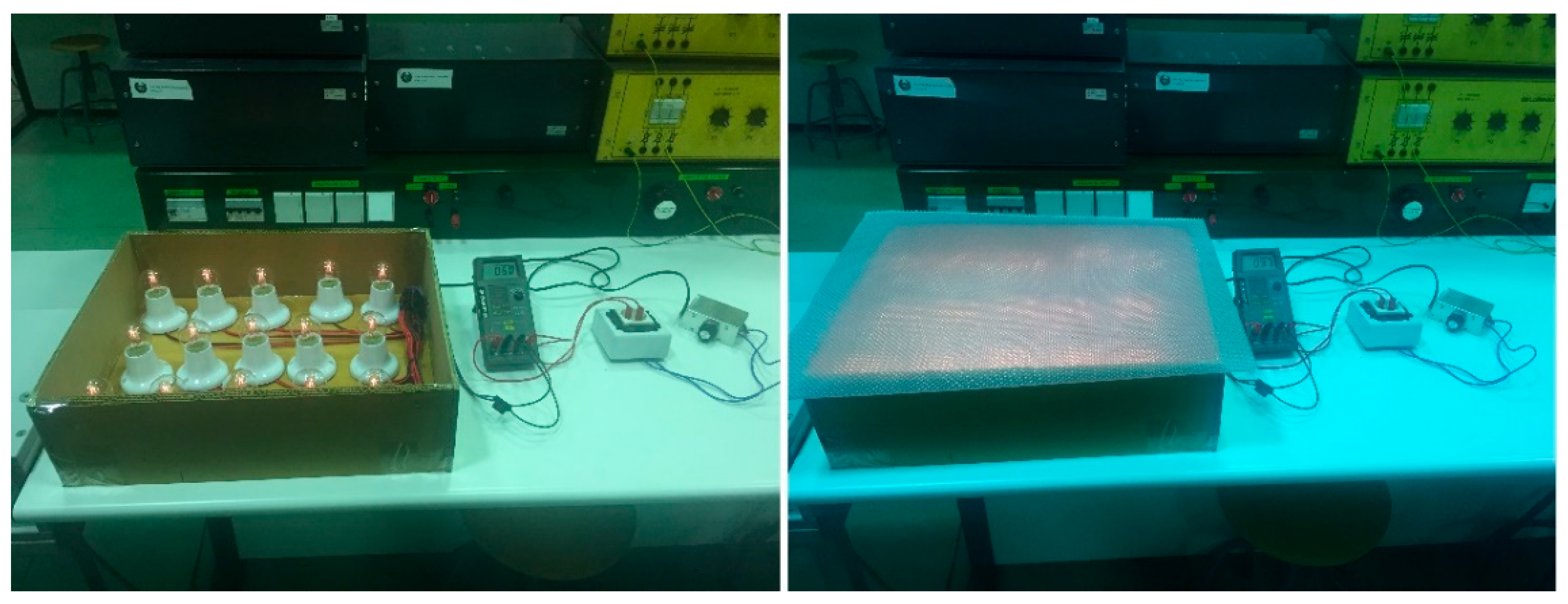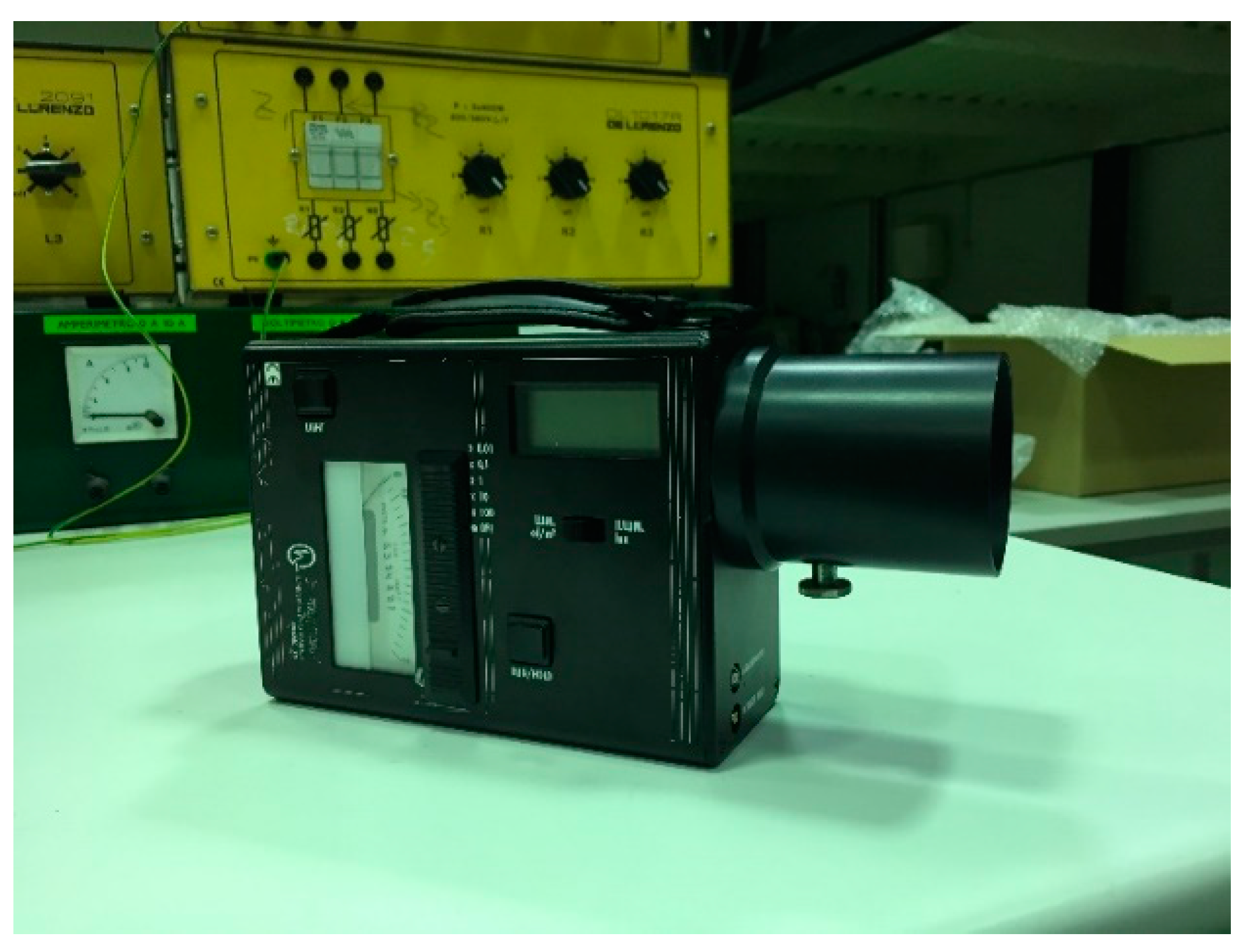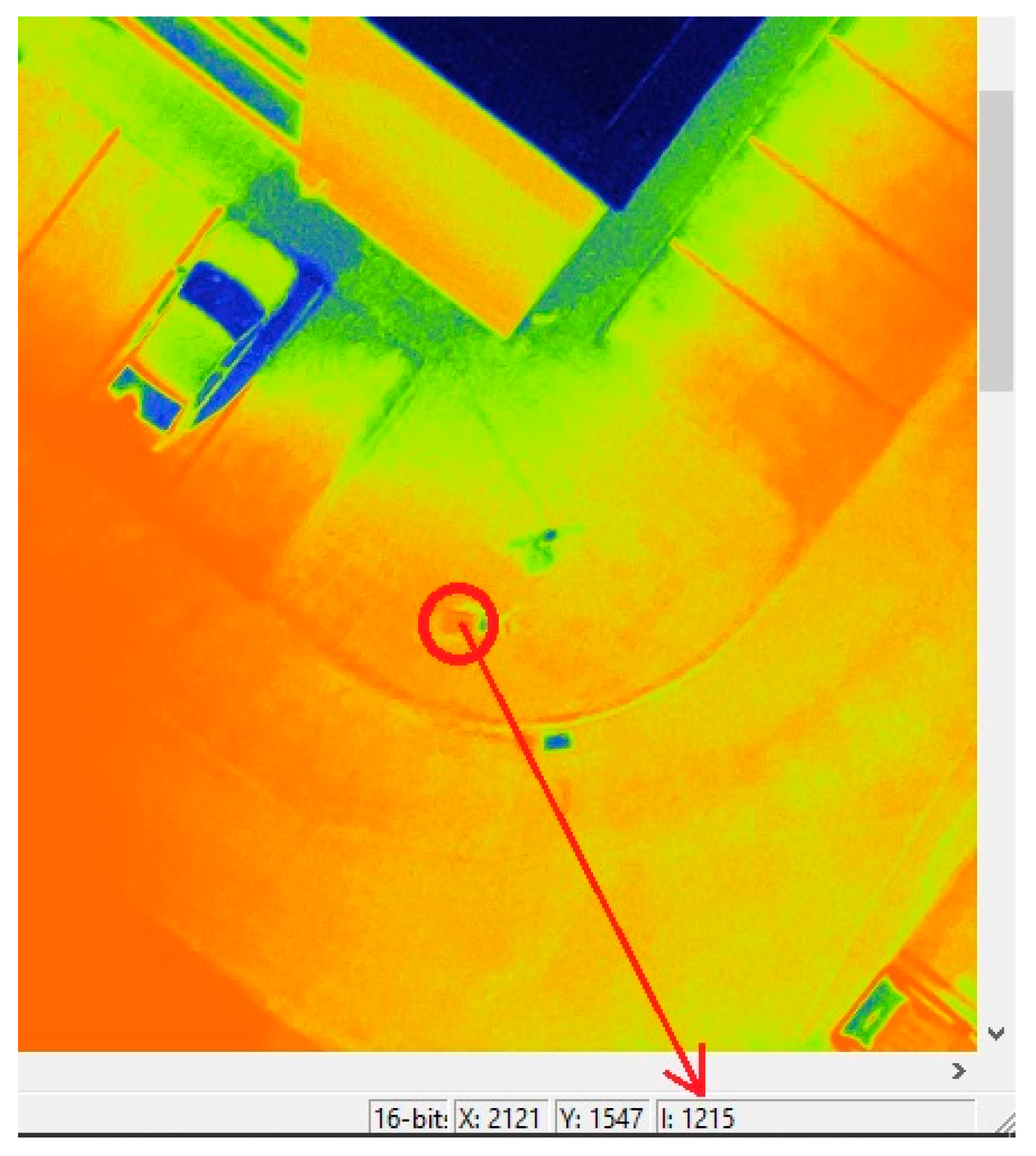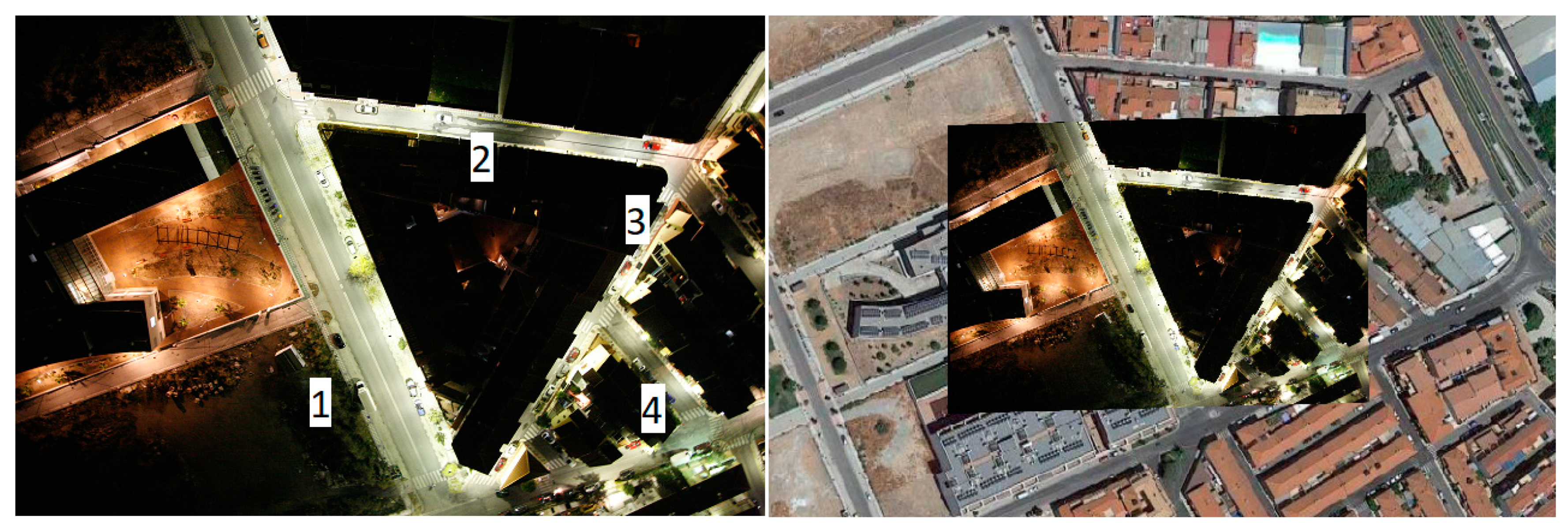Experimental Study of the Levels of Street Lighting Using Aerial Imagery and Energy Efficiency Calculation
Abstract
:1. Introduction
- To obtain reliable information that allows local administrations to make decisions about their public lighting, based on knowledge of which areas have correct lighting levels, according to the classification of roads [15].
- To ascertain the energy efficiency levels of public lighting installations in each street and the entire urban area.
2. Materials and Methods
- Calibration of the digital camera using light patterns of known luminance. This calibration must be carried out in the final working conditions.
- Capture of nocturnal images (orthoimages) of illuminated streets/roads. The previously calibrated airborne digital camera measures the light reflected by the pavement (luminance of the pavement).
- Calculation of the average values of the lighting parameters in the streets/roads with image processing tools.
- Calculation of the electrical power consumed by the lighting installations on each street, using the smart meters located in the public lighting control boxes. To carry out this calculation, it was necessary to have previously audited the elements of the installation (lamps, auxiliary equipment, etc.). Generally speaking, this work is carried out by the public administration that manages the installation.
- Implementation of the lighting levels, luminaire locations, electrical characteristics of the lighting systems, and power consumed on each street into GIS. With all this information, GIS can automatically calculate the energy efficiency of each street. In the GIS software, equations are used to obtain the energy efficiency levels that must be implemented.
2.1. Camera Calibration Procedure
2.2. Method for Measuring Road Lighting
2.3. Energy Efficiency of Street Lighting Installation
2.4. Geographic Information System
3. Results
3.1. Calibration Constant K
3.2. Luminance Measures from Orthoimages
3.3. Examples of Application
4. Discussion
5. Conclusions
Author Contributions
Funding
Acknowledgments
Conflicts of Interest
References
- Sperber, A.N.; Elmore, A.C.; Crow, M.L.; Cawlfield, J.D. Performance evaluation of energy efficient lighting associated with renewable energy applications. Renew. Energy 2012, 44, 423–430. [Google Scholar] [CrossRef]
- Kostic, M.; Djokic, L.; Pojatar, D.; Strbac-Hadzibegovic, N. Technical and economic analysis of road lighting solutions based on mesopic vision. Build. Environ. 2009, 44, 66–75. [Google Scholar] [CrossRef]
- Kostic, M.; Djokic, L. Recommendations for energy efficient and visually acceptable street lighting. Energy 2009, 34, 1565–1572. [Google Scholar] [CrossRef]
- European Commission, DG Environment-C1. Green Public Procurement—Street Lighting and Traffics Lights. Available online: http://ec.europa.eu/environment/gpp/pdf/tbr/street_lighting_tbr.pdf (accessed on 8 August 2018).
- European Committee for Standardization (CEN). Road Lighting. Part 5: Energy Efficiency Requirements; CEN EN 13201:5; CEN: Brussels, Belgium, 2015. [Google Scholar]
- Ministry of Industry, Tourism and Trade of Spain. R.D. 1890/2008 (Regulation of Energy Efficiency in Outdoor Lighting Installations and Their Complementary Technical Instructions EA-01 to EA-07); BOE núm. 279; 19 November 2008. [Google Scholar]
- Riegel, K.W. Light Pollution: Outdoor lighting is a growing threat to astronomy. Science 1973, 30, 1285–1291. [Google Scholar] [CrossRef] [PubMed]
- Fichera, A.; Inturri, G.; LaGreca, P.; Palermo, V. A model for mapping the energy consumption of buildings, transport and outdoor lighting of neighbourhoods. Cities 2016, 55, 49–60. [Google Scholar] [CrossRef]
- Sedziwy, A.; Kotulski, L. Multi-agent system supporting automated GIS-based photometric computations. Procedia Comput. Sci. 2016, 80, 824–833. [Google Scholar] [CrossRef]
- Ekrias, A.; Eloholma, M.; Halonen, L.; Song, X.J.; Zhang, X.; Wen, Y. Road lighting and headlights: Luminance measurements and automobile lighting simulations. Build. Environ. 2008, 43, 530–536. [Google Scholar] [CrossRef]
- Zhou, H.; Pirinccioglu, F.; Hsu, P. A new roadway lighting measurement system. Transp. Res. Part C Emerg. Technol. 2009, 17, 274–284. [Google Scholar] [CrossRef]
- Vaaja, M.T.; Kurkela, M.; Virtanen, J.P.; Maksimainen, M.; Hyyppä, H.; Hyyppä, J.; Tetri, E. Luminance-corrected 3D point clouds for road and street environments. Remote Sens. 2015, 7, 11389–11402. [Google Scholar] [CrossRef]
- Wüller, D.; Gabele, H. The usage of digital cameras as luminance meters. Proc. SPIE 2007, 6502, 65020U. [Google Scholar]
- Xu, Y.; Knudby, A.; Côté-Lussier, C. Mapping ambient light at night using field observations and high-resolution remote sensing imagery for studies of urban environments. Build. Environ. 2018, 145, 104–114. [Google Scholar] [CrossRef]
- International Commission on Illumination (CIE). Lighting of Roads for Motor and Pedestrian Traffic; CIE Public 115; CIE: Vienna, Austria, 2010. [Google Scholar]
- Beccali, M.; Bonomolo, M.; Ciulla, G.; Galatioto, A.; Lo Brano, V. Improvement of energy efficiency and quality of street lighting in South Italy as an action of Sustainable Energy Action Plans. The case study of Comiso (RG). Energy 2015, 92, 394–408. [Google Scholar] [CrossRef] [Green Version]
- Carli, R.; Dotoli, M.; Pellegrino, R. A decision-making tool for energy efficiency optimization of street lighting. Comput. Oper. Res. 2018, 96, 223–235. [Google Scholar] [CrossRef]
- Hiscocks, P.D.; Eng, P. Measuring Luminance with a Digital Camera: Case History. Available online: http://www.ee.ryerson.ca:8080/~phiscock/astronomy/light-pollution/luminance-case-history.pdf (accessed on 18 August 2018).
- CIE. Commission Internationale de l’Eclairage Proceedings, 1924; Cambridge University Press: Cambridge, UK, 1926. [Google Scholar]
- Süsstrunk, S.; Buckley, R.; Swen, S. Standard RGB Color Spaces. In Proceedings of the IS&T/SID’s 7th Color Imaging Conference, Scottsdale, AZ, USA, 16–19 November 1999; pp. 127–134. [Google Scholar]
- Spectroscopy, CCD and Astronomy. Available online: http://www.astrosurf.com/buil/iris-software.html (accessed on 28 August 2018).
- European Committee for Standardization (CEN). Road Lighting. Part 3: Calculation of Performance; CEN EN 13201:3; CEN: Brussels, Belgium, 2003. [Google Scholar]
- International Commission on Illumination (CIE). Road Lighting Calculations; CIE Public 140; CIE: Vienna, Austria, 2000. [Google Scholar]
- Domke, K.; Brebbia, C.A. Light in Engineering, Architecture and Environment; WIT Press: Southampton, UK, 2011; pp. 135–137. ISBN 978-1-84564-550-2. [Google Scholar]
- Rabaza, O.; Gómez-Lorente, D.; Pérez-Ocón, F.; Peña-García, A. A simple and accurate model for the design of public lighting with energy efficiency functions based on regression analysis. Energy 2016, 107, 831–842. [Google Scholar] [CrossRef]
- King, B.; Bridger, G. Review of Road Lighting Design Classification System. 2015. Available online: http://www.energyrating.gov.au/document/report-review-road-lightingdesign-classification-system (accessed on 16 August 2018).
- QGIS. Available online: https://www.qgis.org/en/site/ (accessed on 10 September 2018).
- Alamdarlo, M.N.; Hesami, S. Optimization of the photometric stereo method for measuring pavement texture properties. Measurement 2018, 127, 406–413. [Google Scholar] [CrossRef]
- SAOImage DS9. Available online: http://ds9.si.edu/site/Home.html (accessed on 10 September 2018).
















| Energy Class | SE (W/lx∙m2) | SL (W/cd) |
|---|---|---|
 | 0.000–0.014 | 0.00–0.21 |
| 0.015–0.024 | 0.22–0.36 | |
| 0.025–0.034 | 0.37–0.51 | |
| 0.035–0.044 | 0.52–0.66 | |
| 0.045–0.054 | 0.67–0.81 | |
| 0.055–0.064 | 0.82–0.96 | |
| 0.065–0.074 | 0.97–1.11 |
| Street | Pavement Area (m2) | Electrical Power (W) | Illuminance (lx) | SE (W/lx/m2) | Energy Class |
|---|---|---|---|---|---|
| 1 | 890 | 267.0 | 15 | 0.020 | B |
| 2 | 290 | 191.4 | 16.5 | 0.040 | D |
| 3 | 460 | 182.2 | 12 | 0.033 | C |
| 4 | 250 | 63.0 | 9 | 0.028 | C |
© 2018 by the authors. Licensee MDPI, Basel, Switzerland. This article is an open access article distributed under the terms and conditions of the Creative Commons Attribution (CC BY) license (http://creativecommons.org/licenses/by/4.0/).
Share and Cite
Rabaza, O.; Molero-Mesa, E.; Aznar-Dols, F.; Gómez-Lorente, D. Experimental Study of the Levels of Street Lighting Using Aerial Imagery and Energy Efficiency Calculation. Sustainability 2018, 10, 4365. https://doi.org/10.3390/su10124365
Rabaza O, Molero-Mesa E, Aznar-Dols F, Gómez-Lorente D. Experimental Study of the Levels of Street Lighting Using Aerial Imagery and Energy Efficiency Calculation. Sustainability. 2018; 10(12):4365. https://doi.org/10.3390/su10124365
Chicago/Turabian StyleRabaza, Ovidio, Evaristo Molero-Mesa, Fernando Aznar-Dols, and Daniel Gómez-Lorente. 2018. "Experimental Study of the Levels of Street Lighting Using Aerial Imagery and Energy Efficiency Calculation" Sustainability 10, no. 12: 4365. https://doi.org/10.3390/su10124365
APA StyleRabaza, O., Molero-Mesa, E., Aznar-Dols, F., & Gómez-Lorente, D. (2018). Experimental Study of the Levels of Street Lighting Using Aerial Imagery and Energy Efficiency Calculation. Sustainability, 10(12), 4365. https://doi.org/10.3390/su10124365





